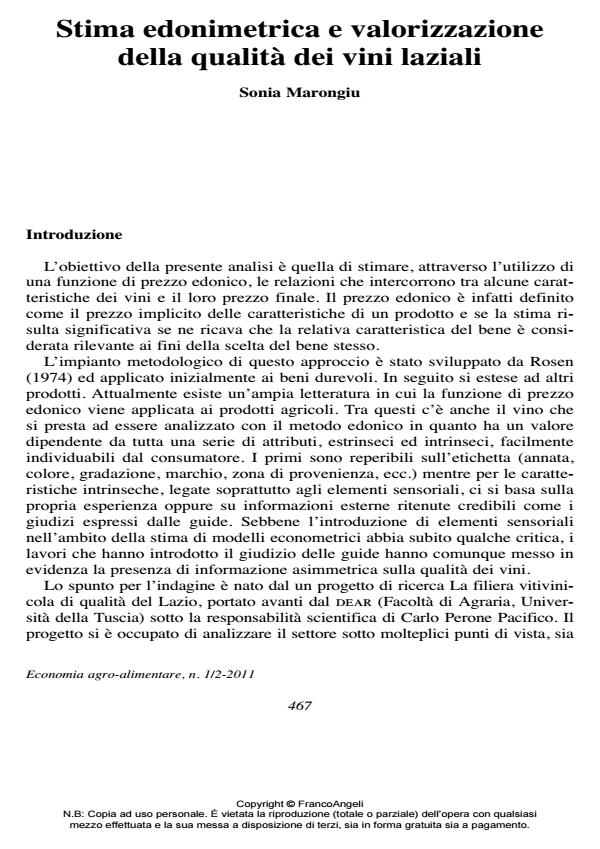Estimation of an hedonic price function and quality valorization of Lazio wines
Journal title ECONOMIA AGRO-ALIMENTARE
Author/s Sonia Marongiu
Publishing Year 2011 Issue 2011/1-2
Language Italian Pages 20 P. File size 396 KB
DOI 10.3280/ECAG2011-001020
DOI is like a bar code for intellectual property: to have more infomation
click here
Below, you can see the article first page
If you want to buy this article in PDF format, you can do it, following the instructions to buy download credits

FrancoAngeli is member of Publishers International Linking Association, Inc (PILA), a not-for-profit association which run the CrossRef service enabling links to and from online scholarly content.
The aim of this paper is to apply the hedonic price method to make an estimation of the influences between some characteristics of wine and its final price. The sample take into account includes the wines that Lazio (a region located in the center of Italy) has presented at Vinitaly in 2007. This sample can be considered representatives of the most important regional firms active in the market wine. As knows, the theoretical framework of the hedonic price method consider that in a differentiated market the consumer utility is generate not only from the consume but also from other benefits connected to the specific quality attributes. The final price is the sum of the implicit prices paid for every these attributes. In case of wine, they can be extrinsic (vintage, colour, grapes, region of origin, presence of pdo or pgi mark, brand name, etc.) or intrinsic (sensorial characteristics, special taste, etc.). In the first case, the evaluation is made using the information available in the wine labels while in the second case it is impossible to made an evaluation before the purchase and consumption. In many cases wine consumers do not have sufficient practice to evaluate this kind of quality and, as a consequence, an important source of information is represented by the wine guides that contain judgment of experts and quality ratings. Starting from a sample of 294 wine labels, the hedonic price function has been estimated using E-Views software (ols method) and making a regression between prices and extrinsic and intrinsic characteristics of wines. The functional form used is the log-linear form. The results put on evidence that red wines have a premium price (+16%) with respect to the white wines and that there is not any influence from the mark policies. Small firms have a premium price (+18%) with respect to big firms. The judgment of experts has a positive correlation to the price: the value of premium price increases when the quality rating increases. No correlation has been found between the presence of pdo/pgi marks and this suggests that in this case the presence of denomination of origin is not associated with quality and do not obtain a premium price. Considering the region of origin, the estimation highlights a premium price for wines produced in Ciociaria, that is a small area in the south of the region that produces a relative small quantity of wines.
Keywords: Hedonic price method, wine sector, quality
Jel codes: C13, Q11
Sonia Marongiu, Stima edonimetrica e valorizzazione della qualità dei vini laziali in "ECONOMIA AGRO-ALIMENTARE" 1-2/2011, pp , DOI: 10.3280/ECAG2011-001020